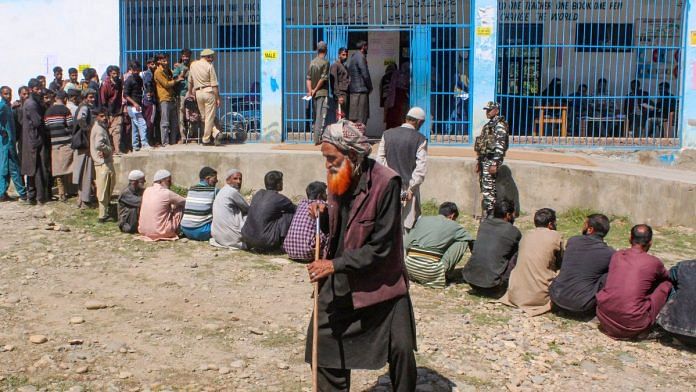Thank you dear subscribers, we are overwhelmed with your response.
Your Turn is a unique section from ThePrint featuring points of view from its subscribers. If you are a subscriber, have a point of view, please send it to us. If not, do subscribe here: https://theprint.in/subscribe/
Early October last year, I visited Kashmir with two objectives – a professional assignment to showcase and a person goal to achieve.
I am a filmmaker and multimedia journalist and lately some of my work had been based out of the Kashmir valley. With the assignment completed, I organized a private screening for all the officials and friends who helped me with it. Then, just before it snowed in the higher altitudes, I also completed a very challenging trek to an alpine lake. It was more a way to test my mental and physical fortitude, before I turned 40 later in the year.
My visit also coincided with a very important time in Kashmir’s politics – the results of its assembly elections that took place after a hiatus of 10 years.
Since the infamous abrogation of article 370 in 2019 that left the region in political limbo, the former state (now a union territory) was to get finally a cabinet.
Considering the kind of attention that Srinagar garners by majoritarian politics in India, I was quite curious to know what the people in this region thought of the elections and what it meant for them. And also, whether they hoped for a better relation with the mainland, its people and governance. I subsequently tried to capture the mood and verve through some pictures, and I shall attempt to summarize what I heard and saw in the following paragraphs.
This wasn’t the first time I was travelling to Kashmir. I have had a myriad of friends from the region whose perspectives, both good and melancholic, formed part of how I knew the region. I also ensured that while in Srinagar, I travelled a lot on foot and in public transport, interacted with the people and immersed myself in the society.
Let me begin by saying that Kashmir is adorned with frames, and anyone, even with a semi-professional camera or an iPhone, a bit of curiosity and a keen eye will be able to get shots that they can be proud of.
Its more what lies underneath the garb – the pleasant, smiling faces with aquiline features reflecting suppressed emotions – something that most mainlanders are oblivious to.
All the Kashmiris that I have known have left the valley at different points in their lives whether for higher education, for employment or for business opportunities. Their choicest of destinations are one of the Indian metros, the middle east and other foreign shores. It in one of these locations that they work and amass their wealth, mostly so that they can build themselves a home in the valley and settle for their retirement.
I have also found that their emphasis on education is second to none; they make good workers and better businesspersons, and are also pleasant people in everyday interactions.
Yet their general relation with India is met with skepticism. Even with those I have had the most amicable relations, I observed that they find solace either amongst their own or in solitude.
Bottling themselves is a reaction due to the general perception of Kashmir by regular Indians, painted as it is with jingoistic fervor that is furthered by Bollywood and its portrayal of the Kashmir conflict. This is further exacerbated by the events of 2019, its coverage by the mainstream media and the celebratory reactions by Indians that has left a deep impact on their psyche in my opinion.
While in Kashmir, it is hard to miss the syncretism of culture and ethnicities. There are a dozen words and syllables in Persian and Sanskrit that are spoken nonchalantly in Kashmiri.
Then there are the pagoda-like mosques unique to the region. The temples, excluding those occupied by the Central Reserve Police Force, interestingly have local muslims delegated by the non-resident priests for their upkeep and maintenance.
While a hundred examples of such harmony and peace present themselves, to a keen observer, it is would be hard to ignore the unease within this synchronous existence. Everyone I have ever met in Kashmir is hospitable, yet their tones reflect insecurity and guardedness. Clarity is met with a sense of confusion and uncertainty, despair and yearning; and of finding small joys with hauntings of a volatile existence.
As the autorickshaw driver who rushed me to get some shots of the aftermath of National Conference’s win said – “There’re as many voices as there are localities in Kashmir – the Gupkar road, Rajbagh, the new town and the downtown.
And more often there are two voices – the second one is heard when the cameras are off”
It was a shame I couldn’t record the tone and tenor in which this was delivered.
These pieces are being published as they have been received – they have not been edited/fact-checked by ThePrint



I completely agree with the article. Kashmiris are often viewed with suspicion, but why should the actions of a small group define an entire ethnicity? This is similar to the harmful stereotype that labels all Muslims or all Pakistanis as terrorists. Such generalizations are not only unfair but also dangerous.
We need to open our eyes, raise our voices, and ensure that the concerns of marginalized communities are heard. India is a democracy, not a dictatorship—yet when it comes to issues like these, many choose to look the other way. Unless it affects them personally, people tend to remain indifferent, which is deeply selfish.
I urge you to promote and support more writers who highlight these issues. Their work needs to reach a wider audience so that people can understand the difference between reality and the narratives pushed by mainstream media. News channels have become a farce—let’s work towards restoring integrity in journalism.